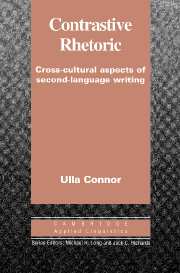Book contents
- Frontmatter
- Contents
- Series editors' preface
- Preface
- I PRELIMINARIES; EARLY PHASES OF THE FIELD
- 1 Toward an extended definition of contrastive rhetoric
- 2 Contrastive rhetoric studies in applied linguistics
- 3 Historical evolution of contrastive rhetoric: from Kaplan's 1966 study to diversification in languages, genres, and authors
- II INTERFACES WITH OTHER DISCIPLINES
- III IMPLICATIONS OF CONTRASTIVE RHETORIC
- References
- Author index
- Subject index
2 - Contrastive rhetoric studies in applied linguistics
Published online by Cambridge University Press: 05 October 2012
- Frontmatter
- Contents
- Series editors' preface
- Preface
- I PRELIMINARIES; EARLY PHASES OF THE FIELD
- 1 Toward an extended definition of contrastive rhetoric
- 2 Contrastive rhetoric studies in applied linguistics
- 3 Historical evolution of contrastive rhetoric: from Kaplan's 1966 study to diversification in languages, genres, and authors
- II INTERFACES WITH OTHER DISCIPLINES
- III IMPLICATIONS OF CONTRASTIVE RHETORIC
- References
- Author index
- Subject index
Summary
In applied linguistics, contrastive rhetoric has been influenced by such major movements as contrastive analysis and research on international Englishes. These influences are discussed in this chapter, followed by sections on current forces affecting contrastive rhetoric research in applied linguistics contexts.
Contrastive analysis, error analysis, and analysis of interlanguage
In the 1950s and 1960s, the theory of second language learning suggested that LI interfered with L2 acquisition. The dominant model of the contrastive analysis hypothesis emphasized the negative, interfering effects of the first language on second language acquisition, which were considered harmful.
By the late 1960s, however, second language learning was being compared to the first language acquisition process, in which language learners are intelligent beings creating rules and systems based on the rule systems of language they hear and use. Among influences in this “creative construction” of language are such sources as a limited knowledge of the L2, knowledge of LI, and knowledge of communication, the world, and other human communicators. New models of second language acquisition and learning emerged, which emphasized the importance of “inter-language” (a system of language that is structurally between LI and L2, Corder 1967; the term was coined by Selinker in 1972). These models, such as Krashen's monitor model (1977), suggested that neither LI nor L2 is a “bad” influence on second language acquisition.
Teachers of ESL and foreign languages have always been familiar with the negative effects of transfer; they recognize that their students speak the target language with an accent that reflects phonemic characteristics of the student's native language.
- Type
- Chapter
- Information
- Contrastive RhetoricCross-Cultural Aspects of Second Language Writing, pp. 12 - 27Publisher: Cambridge University PressPrint publication year: 1996
- 1
- Cited by



